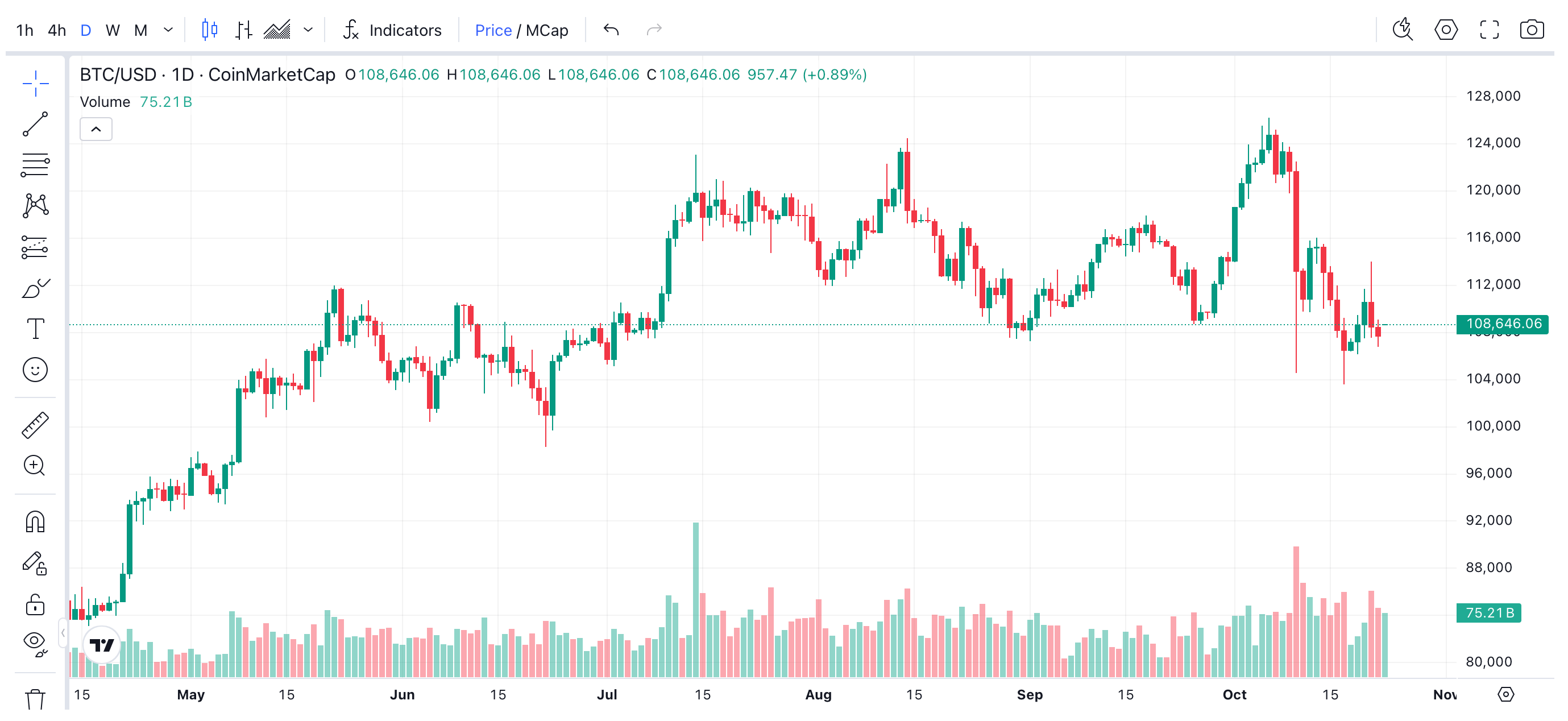Bitcoin's price trajectory in late 2025 has become a focal point for investors, with analysts divided between bullish optimism and tactical caution. After reaching all-time highs near $125,500 in early October, BTC corrected sharply to around
$107,000
, triggering debates over whether this dip represents a buying opportunity or the start of a deeper downturn. This article synthesizes insights from major institutions—including CoinGecko, 10x Research, and VanEck, to explore Bitcoin's potential paths forward, examining on-chain metrics, macroeconomic drivers, and sentiment indicators shaping its future.
BTC price. Source: TradingView
Institutional Price Targets: Bullish Long-Term, Cautious Short-Term
While long-term forecasts remain overwhelmingly positive, short-term predictions reflect heightened volatility.
Standard Chartered reaffirmed its $200,000 year-end target, with analyst Geoffrey Kendrick describing dips below $100,000 as a potential "last chance" to accumulate before parabolic gains. Similarly,
10x Research projects $142,000 by year-end, citing anticipated inflows of
$1.4 trillion into crypto markets.
However, 10x Research has turned tactically bearish for October, warning of a possible drop to
$100,000 as institutional investors reduce exposure and on-chain momentum wanes. This dichotomy highlights the tension between transient sell-offs and structural bullishness. Meanwhile,
VanEck characterizes the pullback as a "mid-cycle reset," emphasizing Bitcoin's role as an anti-inflation hedge amid expanding global liquidity.
VanEck's comment on BTC. Source: Cointelegraph X account
On-Chain Metrics: Accumulation vs. Speculative Excess
Bitcoin's network data reveals robust institutional accumulation despite price turbulence. Over
$57.5 billion in BTC has exited exchanges since September, which is a sign of long-term holding—while wallets holding 100–10,000 BTC have accelerated their buying. The
MVRV Z-Score, which assesses whether Bitcoin is overvalued relative to its historical average, currently sits at
2.15, below the 3.0 threshold associated with cycle tops. This suggests room for growth before overheating.
Conversely, the
Pi Cycle Oscillator has begun trending upward, mirroring patterns seen before the 2021 bull run. Yet, declining daily transactions (down
41% since 2024) indicate retail participation remains subdued, underscoring a shift toward "whale-driven" markets.
Macroeconomic Tailwinds and Regulatory Catalysts
Bitcoin's correlation with global liquidity—particularly the
M2 money supply, now exceeding
$90 trillion—continues to explain over half of its price variance. The Federal Reserve's "skinny master account" program, enabling fintechs to access its payment system, could further bolster Bitcoin's integration into traditional finance.
Policies like the
GENIUS Act and Trump's
Strategic Bitcoin Reserve proposal have reinforced institutional confidence, with 28 U.S. states are now allocating treasury reserves to BTC. These developments, coupled with spot ETF inflows totaling
$5.95 billion in October alone, create a supportive backdrop for long-term appreciation.
Sentiment Analysis: Greed, Fear, and Cycle Lags
BTC 2025 ATH prediction. Source: CoinGecko
Retail optimism remains extreme, with
86.7% of CoinGecko survey respondents expecting new all-time highs above $124,128 in 2025. However, the "Fear and Greed Index" hit
95% euphoria in early October, which is a historical precursor to corrections.
Notably, Bitcoin's current cycle lags
30 days behind the 2017 bull run, with a
93% correlation in price action. If this pattern holds, the consolidation phase could extend through mid-November before resuming its upward trajectory.
Key Risks and Downside Scenarios
Leverage flush-outs pose near-term threats. Futures open interest peaked at $52 billion in October, triggering cascading liquidations that amplified the drop to $105,000. A break below $100,000 could ignite panic selling, with technical analysts identifying $95,000 as the next critical support.
Regulatory uncertainty also looms. While recent policies have been favorable, evolving securities laws could complicate institutional adoption.
Conclusion
Bitcoin is at a pivotal juncture. Short-term headwinds—leveraged unwinding, emotional retail sentiment, and cyclical lags—support 10x Research's cautionary outlook for a $100,000 test. However, structural pillars, institutional demand, supply scarcity, and macroeconomic hedge appeal keep year-end targets of $142,000–$200,000 plausible.
Investors should monitor ETF flow trends, the MVRV Z-Score, and Bitcoin's adherence to its 200-day SMA (~$107,800) for signals of the next directional move. As VanEck notes, systematic exposure during pullbacks may offer an optimal strategy for capitalizing on Bitcoin's long-term growth narrative.
References:
CoinCatch Team
Disclaimer:
Digital asset prices carry high market risk and price volatility. You should carefully consider your investment experience, financial situation, investment objectives, and risk tolerance. CoinCatch is not responsible for any losses that may occur. This article should not be considered financial advice.





